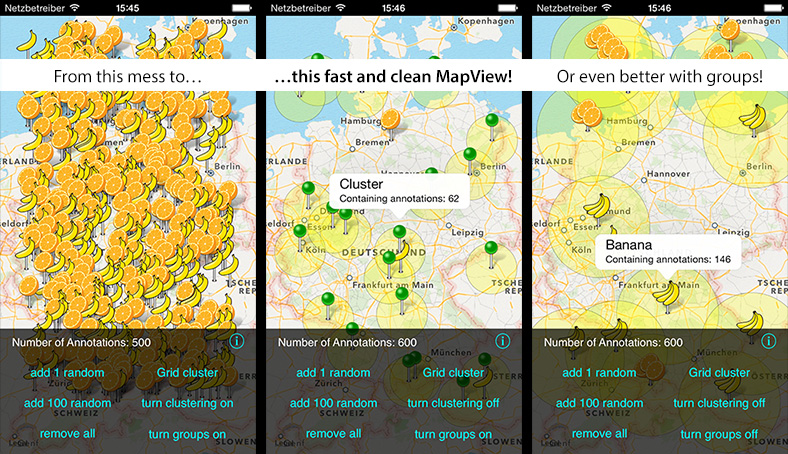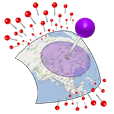OpenClusterMapView is a simple and easy to use extension of MKMapView for iOS. If you are displaying a lot of annotations on the map, this class is made for you.
OCMapView automatically creates clusters by combining annotations super fast. It works with any iOS application. No code changes needed.
- Fast and easy! Handle over 9000 annotations on the map at once.
- Very simple usage! No code changes needed, just replace the MapView class
- Easy to integrate! Keep all
MKMapViewdelegate methods as they are - Customize the
MKAnnotationViewsof generated clusters like any other annotation - Customize behavior like the cluster size
- Two different clustering algorithms
- Provide an ignore list of annotations, that wont be clustered
- Create independent clusters by using groups
- Just install the pod using
pod 'OCMapView'
- Add the
OCMapViewfolder to your project. - Link with the
MapKitandCoreLocationframeworks
You may already have encountered the problem: When adding a several hundred annotations to the MKMapView, it will get laggy and everything but user friendly.
Many developers believe that iOS can't handle a huge amount of annotations on a MKMapView due to the low memory capacities of iDevices. So they start to handle the annotation management themselves with pretty dumb filter methods which won't display all annotations and confuse users even more.
The actual problem is not memory related. It rather occurs because annotationViews are UIViews and these are extremely slow. So if you scroll/zoom a MKMapView with many annotations, iOS has to redraw them all at once and that will take time.
OCMapView combines multiple annotations in a specified range and displays them just as a single annotationView for the whole cluster. So you'll never have too many views which make your app slow and laggy. In addition to that forget to handle the annotations yourself! Just add them all to your OCMapView and it will do everything for you. Even the iPhone 3G with iOS 3.1.x can handle a couple thousand annotations without lagging!
Just replace your MKMapView references with OCMapView. It automatically handles annotations and combines them to clusters for you without any other change of your code.
Add the annotations you want to display as usual and implement the same MKMapViewDelegate methods like before. The handling stays completely the same so you can easily use custom views for your annotations and clusters. The viewForAnnotation delegate method will return OCAnnotation objects for generated clusters. This is how to provide custom views:
- (MKAnnotationView *)mapView:(MKMapView *)aMapView viewForAnnotation:(id <MKAnnotation>)annotation{
// if it's a cluster
if ([annotation isKindOfClass:[OCAnnotation class]]) {
// create your custom cluster annotationView here!
}
// If it's a single annotation
else if([annotation isKindOfClass:[Your_Annotation class]]){
// create your custom annotationView as regular here!
}
return Your_annotationView;
}
For more informations, have a look at the example project.
You can cluster different groups of annotations, as seen on the screenshots above, like this:
Implement the OCGrouping protocol on your annotation class, set its grouping-tag and set the clusterByGroupTag property of your OCMapView to true. Take a look at the sample project to see how it works.
Apps that use OCMapView:
- official Car2Go App
- cost control for Car2Go aka. aCar2Go
- AbHof
- and a lot of more who do not tell me ;)
If you are using OCMapView and want to contribute, please contact me to add your app to the list of supporting apps!

